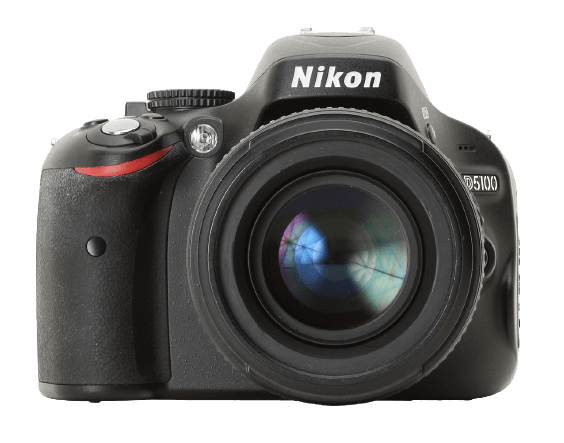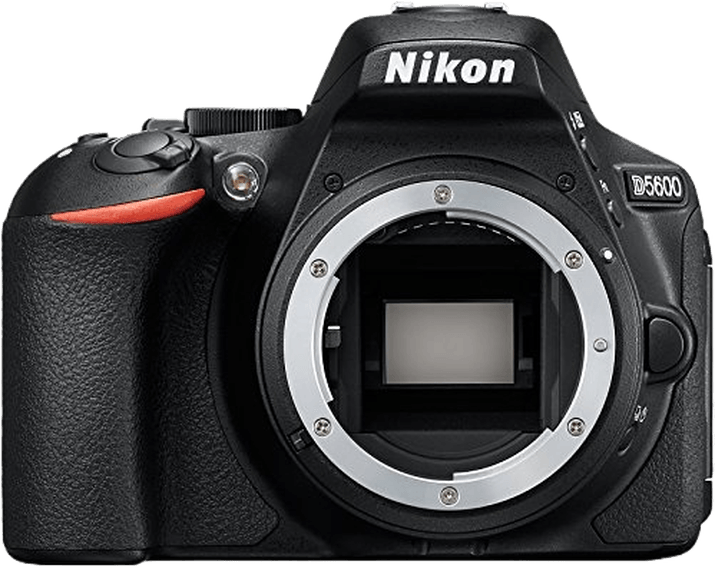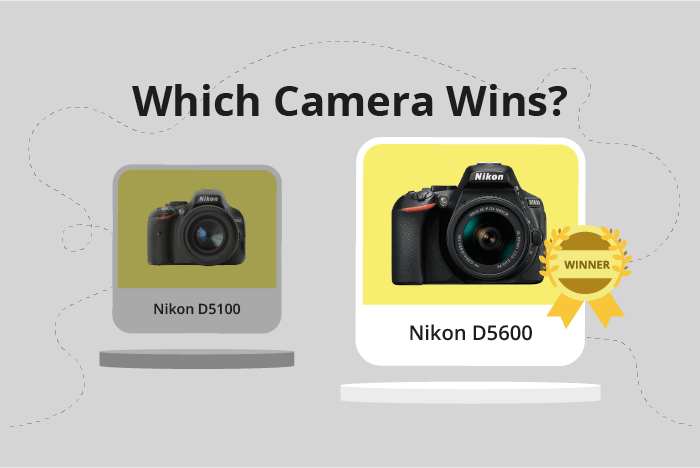Nikon D5100 vs D5600 Comparison
Nikon D5100

Nikon D5600

The Nikon D5600 takes the lead with a score of 66/100, while the Nikon D5100 scores 49/100. Both cameras are DSLR models and were released in 2011 and 2016, respectively. They share similar dimensions, with the D5600 being slightly smaller at 124 x 97 x 70mm compared to the D5100’s 128 x 97 x 79mm.
The D5600 outperforms the D5100 in several aspects, including a lighter weight of 465g compared to 560g. It also has a lower launch price of $700, compared to the D5100’s $799. These factors contribute to the D5600’s higher score and make it a more appealing choice for consumers.
The D5100, however, may still have some advantages for certain users, depending on their specific needs and preferences. Nonetheless, the Nikon D5600 stands out as the winner in this comparison due to its better overall specifications and value for money.
Nikon D5100 vs D5600 Overview and Optics
The Nikon D5600 outperforms the Nikon D5100 in optics with a score of 65/100 compared to 52/100. Both cameras share some common specifications, such as the CMOS sensor type, APS-C sensor size, Nikon F DX lens mount, and lack of image stabilization.
The D5600 excels in several aspects, including a higher megapixel count of 24.2, which allows for greater image detail and larger prints. Additionally, the D5600 has a faster shooting speed of 5 frames per second, enabling photographers to capture fast-moving subjects more effectively. The improved Expeed 4 processor in the D5600 ensures faster image processing and better overall performance. Lastly, the D5600 has a higher DXOMARK score for the sensor at 84, indicating superior image quality and low-light performance.
On the other hand, the D5100 has a lower megapixel count of 16.2 and a slower shooting speed of 4 frames per second. Its Expeed 2 processor is not as advanced as the D5600’s Expeed 4, which may affect overall camera performance. Despite these drawbacks, the D5100 still provides satisfactory image quality with a DXOMARK score of 80 for its sensor.
Considering the advantages of the D5600, it is the superior option for those seeking better optics and overall performance. The higher megapixel count, faster shooting speed, and more advanced processor contribute to its higher score and better image quality. While the D5100 may suffice for casual photographers, the D5600 is a more capable and versatile choice for those looking to elevate their photography skills.
Nikon D5100 vs D5600 Video Performance
The Nikon D5600 has a higher video score, reflecting its solid performance in this area. However, the d5100 is still a good choice for casual use.
Both cameras are capable of recording Full HD video with a maximum resolution of 1920 x 1080 pixels. Additionally, the D5600 can capture video at a maximum frame rate of 60 frames per second, ensuring smooth and high-quality footage. The D5100 falls behind with a lower max frame rate.
Nikon D5100 vs D5600 Features and Benefits
The Nikon D5600 emerges as the winner with a feature score of 72/100, while the Nikon D5100 scores 41/100. Both cameras share some common specifications, such as a 3-inch (D5100) and 3.2-inch (D5600) screen size, flip screen functionality, and the absence of GPS.
The Nikon D5600 surpasses the D5100 in several aspects. It boasts a higher screen resolution of 1,037,000 dots compared to the D5100’s 921,000 dots, enhancing image preview and menu navigation. The D5600 also includes a touchscreen, making it more user-friendly and efficient for adjusting settings and reviewing images. Furthermore, the D5600 has built-in WIFI and Bluetooth capabilities, enabling easy and quick sharing of photos and videos, as well as remote camera control.
On the other hand, the Nikon D5100 does not offer any significant advantages over the D5600. It lacks a touchscreen, WIFI, and Bluetooth, making it less convenient for modern photographers who value connectivity and ease of use.
Based on these comparisons, the Nikon D5600 clearly outperforms the Nikon D5100 in terms of features. With a higher screen resolution, touchscreen, and connectivity options, the D5600 caters to the needs of today’s photographers, while the D5100 falls short in offering those essential features. Therefore, the Nikon D5600 is the superior choice for photographers seeking advanced functionality and convenience in their camera.
Nikon D5100 vs D5600 Storage and Battery
The Nikon D5100 outperforms the Nikon D5600 in storage and battery with a score of 51/100, compared to the D5600’s 43/100. Both cameras share common specifications, such as having one memory card slot and accepting SD, SDHC, and SDXC memory cards. However, the D5600 is compatible with faster UHS-I cards.
The D5100 surpasses the D5600 in battery life, offering 2200 shots per charge, while the D5600 only provides 970 shots. Both cameras use similar battery types, with the D5100 using an EN-EL14 and the D5600 using an EN-EL14a. Neither camera supports USB charging.
Although the D5100 has a longer battery life, the D5600’s compatibility with UHS-I memory cards allows for faster data transfer. This feature may be more important to some users, depending on their shooting needs and preferences.
Considering the storage and battery aspects, the Nikon D5100 proves to be a better choice due to its longer battery life. However, the Nikon D5600 offers improved memory card compatibility, which could be a deciding factor for specific users.
Alternatives to the Nikon D5100 and D5600
Are you still undecided about which camera is right for you? Have a look at these popular comparisons that feature the Nikon D5100 or the Nikon D5600:

